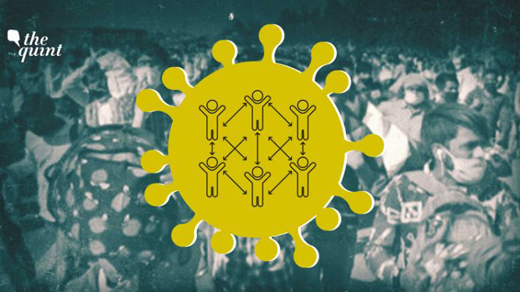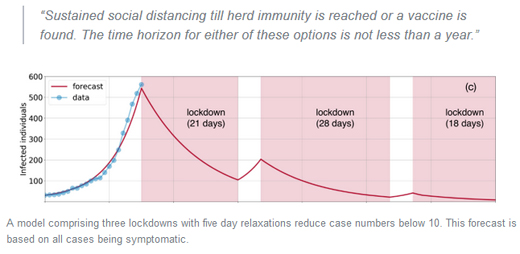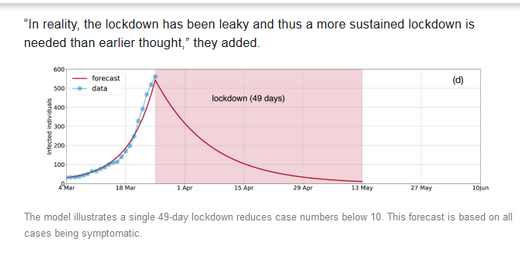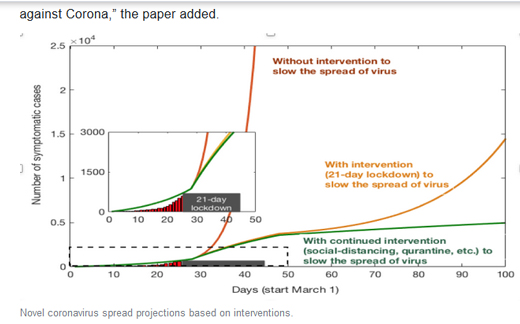Mathematical Models warn several lockdowns needed to beat COVID-19
Mathematical Models warn several lockdowns needed to beat COVID-19
mangaloretoday.com/ theQuint
Scientists who had conducted recent mathematical modelings of the spread of COVID-19 in India say Prime Minister Narendra Modi’s announcement of an extension of the nationwide lockdown is a vindication of their predictions.
At the commencement of the lockdown, on 25 March, several academics including those at Cambridge University, Institute of Mathematical Sciences (IMS), Chennai and Shiv Nadar University had run mathematical projections to analyse and predict the spread of the novel coronavirus in the country.

A common conclusion among them was the insufficiency of a 21-day lockdown and the need to have several periods of sustained lockdowns to flatten the curve and eliminate the transmission of the virus. The verdict on the effectiveness of the extended 40-day lockdown is yet to be measured.

In a televised address to the nation, PM Modi announced that the prevailing lockdown would be extended from 15 April to 3 May. He also added that the fight against coronavirus will be made more stringent over the following week and that some conditional relaxations will be allowed after 20 April, in places where there are no hotspots.
Mathematical modelling and projections have been at the forefront globally in the battle against the novel coronavirus. Across the world, including India, the models have informed policymakers of issues such as the enforcement of social distancing, identification of transmission patterns and demographical aspects.
‘Exit Strategies May Take Up to a Year’
Dr Singh and Dr Adhikari had presented an age-structured mathematical model that studied the progress of the COVID-19 pandemic in India.
The modelling, conducted at the commencement of the lockdown period, had found that, “A three-week lockdown is found insufficient to prevent a resurgence and, instead, protocols of sustained lockdown with periodic relaxation are suggested.”
According to Dr Singh and Dr Adhikari, there are only two possible exit strategies at present:

“Our paper constructs the best possible scenario, that the lockdown is instantaneous and complete, and finds that a 21-day lockdown will be insufficient,” said the researchers.
“In reality, the lockdown has been leaky and thus a more sustained lockdown is needed than earlier thought,” they added.
Dr Samit Bhattacharyya, at the Department of Mathematics and Dr Naga Suresh Veerapu, Assistant Professor, Department of Life Sciences at Shiv Nadar University have also strongly endorsed an extension of lockdown.
Having presented a model-based prediction of the lockdown period, they had concluded their paper stating that, “We should very much expect a surge of cases after the 21-day lockdown period.”
“The 21-day lockdown only helps us buy time to prepare ourselves for better fight against Corona,” the paper added.

“Our mathematical projection shows that the spread of SARS-CoV-2 is a highly non-linear process,” Dr Bhattacharya and Dr Veerapu told The Quint, adding that, “As our model also exhibits, extending lockdown on hotspot regions, planning for aggressive testing and systematic surveillance, isolating and quarantining suspected cases should be continued, at least for a significant period, which may help flatten the COVID-19 curve.”
How Mathematical Models Are Helping Fight COVID-19
To understand the behaviour of the novel coronavirus, predict the spread and impact of the disease under various conditions in different communities, mathematical models are being widely deployed across the world
Many of the models, however, are unique to individual academic groups but the mathematical principles are similar. They are based around trying to understand how people move between three main states, and how quickly:
A common method is the ‘SIR’ model. Individuals are either susceptible (S) to the virus; have become infected (I); and then either recover (R) or die.
"“A mathematical model can aid in qualitative understanding and quantitative predictions on the spread of the COVID-19. The model predictions should be seen as a warning.”" - Dr Rajesh Singh, Centre for Mathematical Sciences, University of Cambridge
“But to inform policy, other perspectives, such as economic, medical, social and ethical ones need to be considered in our fight against the spread of COVID-19,” Dr Singh added.
Mathematical simulations work with what is known as the ‘reproduction number’ – symbolised as R0 (pronounced R-naught). It is an indication of how contagious an infectious disease is. In the context of COVID-19, R0 means the number of people, on average, to whom one infected person will pass the virus.
In the case of Dr Singh and Dr Adhikari’s study, “Age-structured impact of social distancing on the COVID-19 epidemic in India” the basic reproductive ratio R0 and its time-dependent generalisation are computed based on case data, age distribution and social contact structure.
Shiv Nadar University’s paper states that it “embarked onto project number of symptomatic cases during a presumed no intervention period (21-day lockdown) by considering R0 = 2.2”
Shiv Nadar University’s Dr Bhattacharya describes predictive modelling as “a powerful emerging tool to project the outcome of what-if analysis of non-linear processes such as the transmission of an infection in a population.”
"“Modelling not only helps to identify the slope of the trajectory, the way infection may go up or down over time but also assists in understanding the severity and geographical spread of the infection by identifying hotspots of transmission in regions.”" - Dr Samit Bhattacharyya, Dept of Mathematics & Dr Naga Suresh Veerapu, Dept of Life Sciences, Shiv Nadar University
Moreover, models also help analyse pre-lockdown and post-lockdown effects on disease transmission under different scenarios such as duration and places of lockdown, its frequency, which may help the public health of the country in its strategic planning.
- ’Put America first’: Trump’s big warning to tech firms against hiring Indians
- 2 Odisha brothers rape teen, try to bury her alive when she’s 5 months pregnant
- WWE legend Hulk Hogan dies at 71 after cardiac arrest
- 2 booked as woman dangerously performs ‘aura farming’ trend on Mercedes-Benz car in Navi Mumbai
- Lok Sabha to run smoothly from Monday as Om Birla meets party leaders
- No fault with boeing fuel control unit: US Aviation body on Air India crash
- Centre bans OTT platforms Ullu, ALTT, Desiflix for obscene content
- Missile launched from a drone: Major boost to India’s military capabilities
- RCB star Yash Dayal faces another sexual assault case, this time for raping minor
- Narendra Modi becomes 2nd longest serving PM, breaks Indira Gandhi’s record
- Arrested Al-Qaeda terrorists were in touch with Pak, ISI during Op Sindoor
- At least 4 children killed, 17 injured after govt school building collapse in Rajasthan
- Puttur: Bail plea of Krishna J. Rao rejected in case of cheating student on pretext of marriage
- Subrahmanya: Missing ambulance driver’s body found in river after four-days search
- Sullia: Four youths killed in car-lorry collision on Mani–Mysuru highway near Koyanadu
- INTACH to host cultural dialogue with author Srikar Raghavan
- Belthangady: Man held for assaulting wife over dowry on Honeymoon
- Dharmasthala mass burials: SIT sleuths head to temple town to begin probe
- Udupi: Deputy director, assistant arrested by lokayukta for demanding bribe
- Mangaluru: Traffic resumes smoothly on Kuloor bridge after repairs
- MP Brijesh Chowta meets Minister Nitin Gadkari in Delhi, urges implementation of key infrastructure projects
- Rape-murder convict Govindachamy caught hours after escape from Kannur Central Jail
- Dharmasthala crimes: IPS officer Soumyalatha opts out of SIT
- 2008 Ullal terror case: Prime accused Yasin Bhatkal produced via video conference
- Red alert: Schools in Dakshina Kannada, Udupi to remain closed on Friday
- Daiva’s prediction comes true: Janardhan Reddy walks free from jail
- Skills and Competencies Take Center Stage at MSN Dialogue Series
- Court remands Maoist Lakshmi to six-day police custody
- Sandhya Shenoy honored with Society for Materials Chemistry Medal-2024
- White Cornus Apartment in Mangaluru
- City girl wins first place in state-level spell bee competition
- Alleged ‘Love Jihad’ Case in Mangaluru: Woman left home voluntarily, says police
- Girl fatally struck by reckless two-wheeler near Belman
- New residential complex for the judges inaugurated in Mangaluru
- Absconding accused nabbed after 8 years
- Truck with cylinders turns turtle in Beltangady
- Bhoota Kola artist dies of cardiac arrest
- Development of the country should be our goal: Ganesh Karnik
- Container truck gets stuck under Modankap railway bridge
- Truck crushes bike’s pillion rider near BC Road
- CITY INFORMATION
- TRAVEL
- TOURIST INFORMATION
- HEALTH CARE
- MISCELLANEOUS




 Write Comment
Write Comment E-Mail
E-Mail Facebook
Facebook Twitter
Twitter  Print
Print 


